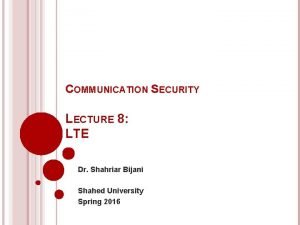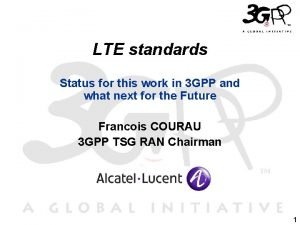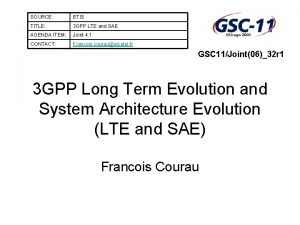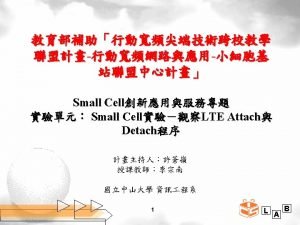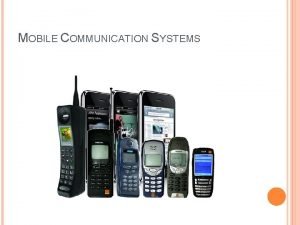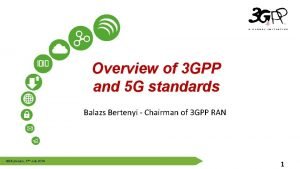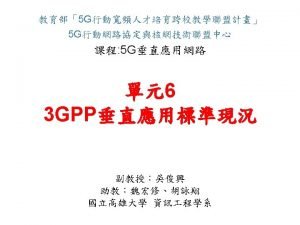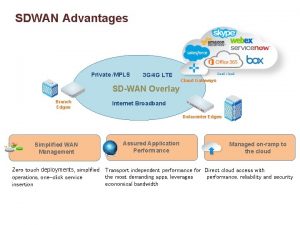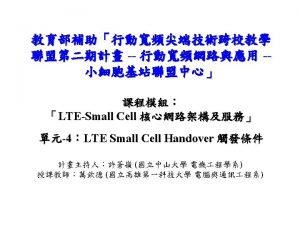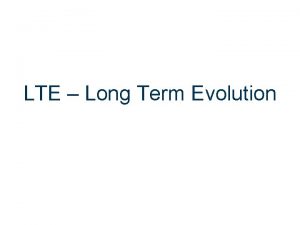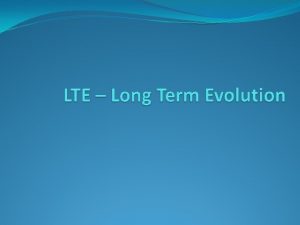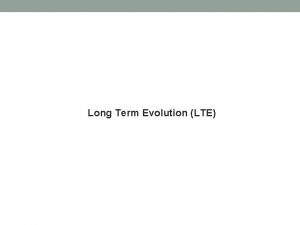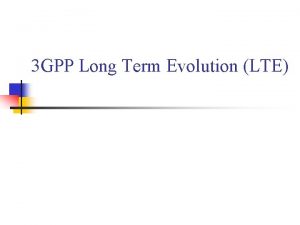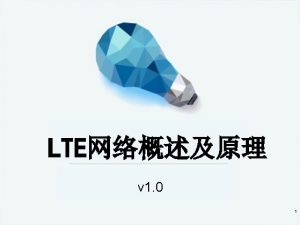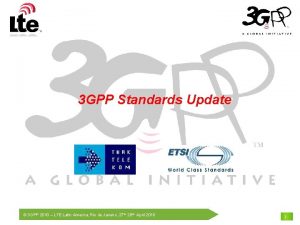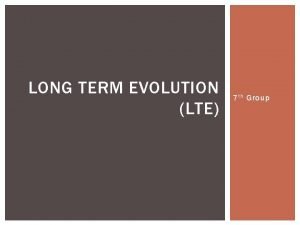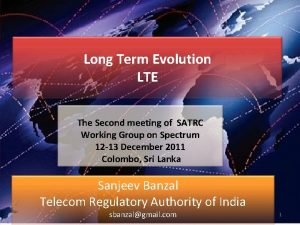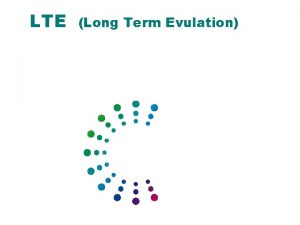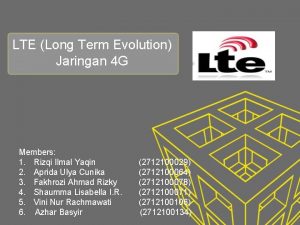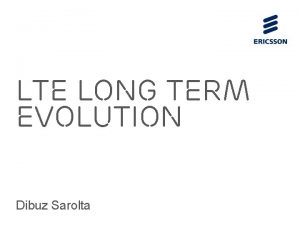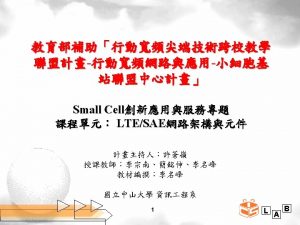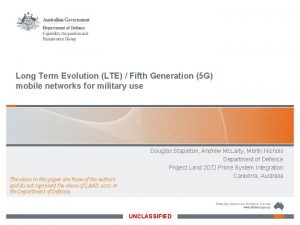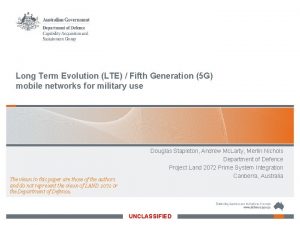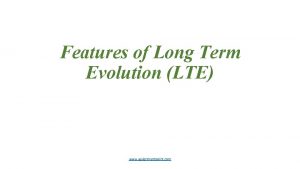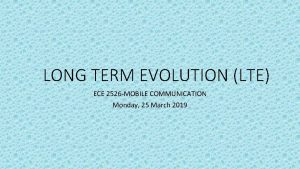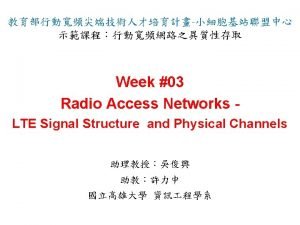3 GPP Long Term Evolution LTE Outline n


























- Slides: 26

3 GPP Long Term Evolution (LTE)

Outline n n n History of 3 GPP LTE Basic Concepts of LTE Introduction of LTE Protocol Comparison of LTE and LTE-Advanced Conclusion 2

What is LTE ? n In Nov. 2004, 3 GPP began a project to define the long-term evolution (LTE) of Universal Mobile Telecommunications System (UMTS) cellular technology n n n Higher performance Backwards compatible Wide application 3

Evolution of Radio Access Technologies 802. 16 m 802. 16 d/e n n LTE (3. 9 G) : 3 GPP release 8~9 LTE-Advanced : 3 GPP release 10+ 4

LTE Basic Concepts n LTE employs Orthogonal Frequency Division Multiple Access (OFDMA) for downlink data transmission and Single Carrier FDMA (SC-FDMA) for uplink transmission 5

Multipath-Induced Time Delays Result in Inter-Symbol Interference (ISI) βS(t-m) S(t) y(t) : output signal S(t) : input signal S(t-m) : delayed m time input signal n(t) : noise y(t) 6

Equalizers in Receiver n Against Frequency Selective Fading n Channel transform function Hc(f) n Equalizers transfer function, Heq(f) (Receiver) 7

Frequency Selective Fading n Coherence bandwidth of the channel is smaller than the bandwidth of the signal Frequency Correlation > 0. 9 Bc = 1 / 50α α is r. m. s. delay spread It may be useless even in increasing transmission power 8

Cyclic Prefixes against multipath 9

FDM vs. OFDM 10

LTE-Downlink (OFDM) n n n Improved spectral efficiency Reduce ISI effect by cyclic prefix Against frequency selective fading 11

LTE Uplink (SC-FDMA) n SC-FDMA is a new single carrier multiple access technique which has similar structure and same performance to OFDMA A salient advantage of SCFDMA over OFDM is low to Peak to Average Power Ratio (PAPR) : Increasing battery life 12

Multi-antenna techniques 13

Generic Frame Structure n Allocation of physical resource blocks (PRBs) is handled by a scheduling function at the 3 GPP base station (e. Node. B) Frame 0 and frame 5 (always downlink) 14

Resource block One frame is 10 ms 10 subframes 20 slots n One subframe is 1 ms 2 slots n One slot is 0. 5 ms N resource blocks [ 6 < N < 110] n One resource block is 0. 5 ms and contains 12 subcarriers from each OFDM symbol n 15

LTE spectrum (bandwidth and duplex) flexibility 16

LTE Release 8 Key Features (1/2) n n n High spectral efficiency n OFDM in Downlink n Single‐Carrier FDMA in Uplink Very low latency n Short setup time & Short transfer delay n Short hand over latency and interruption time Support of variable bandwidth n 1. 4, 3, 5, 10, 15 and 20 MHz Compatibility and interworking with earlier 3 GPP Releases FDD and TDD within a single radio access technology Efficient Multicast/Broadcast 17

Evolution of LTE-Advanced n n n Asymmetric transmission bandwidth Layered OFDMA Advanced Multi-cell Transmission/Reception Techniques Enhanced Multi-antenna Transmission Techniques Support of Larger Bandwidth in LTEAdvanced 18

Asymmetric transmission bandwidth n Symmetric transmission n n voice transmission : UE to UE Asymmetric transmission n streaming video : the server to the UE (the downlink) 19

Layered OFDMA n n The bandwidth of basic frequency block is, 15– 20 MHz Layered OFDMA radio access scheme in LTE-A will have layered transmission bandwidth, support of layered environments and control signal formats 20

Advanced Multi-cell Transmission/Reception Techniques n In LTE-A, the advanced multi-cell transmission/reception processes helps in increasing frequency efficiency and cell edge user throughput n n Estimation unit Calculation unit Determination unit Feedback unit 21

Enhanced Multi-antenna Transmission Techniques n n In LTE-A, the MIMO scheme has to be further improved in the area of spectrum efficiency, average cell through put and cell edge performances In LTE-A the antenna configurations of 8 x 8 in DL and 4 x 4 in UL are planned 22

Enhanced Techniques to Extend Coverage Area n Remote Radio Requirements (RREs) using optical fiber should be used in LTE-A as effective technique to extend cell coverage 23

Support of Larger Bandwidth in LTE-Advanced n Peak data rates up to 1 Gbps are expected from bandwidths of 100 MHz. OFDM adds additional sub-carrier to increase bandwidth 24

LTE vs. LTE-Advanced 25

Conclusion n n LTE-A helps in integrating the existing networks, new networks, services and terminals to suit the escalating user demands LTE-Advanced will be standardized in the 3 GPP specification Release 10 (LTE-A) and will be designed to meet the 4 G requirements as defined by ITU 26
 Gpp lte means
Gpp lte means Gpp lte meaning
Gpp lte meaning Gpp lte
Gpp lte Lte attach procedure
Lte attach procedure Long term evolution advanced
Long term evolution advanced Short, medium and long term planning in education
Short, medium and long term planning in education Long term memory vs short term memory
Long term memory vs short term memory Long term hr planning
Long term hr planning Difference between long term and short term liabilities
Difference between long term and short term liabilities Long term liabilities
Long term liabilities Short term goals
Short term goals Short term financial management
Short term financial management Tall + short h
Tall + short h Once upon a time lived
Once upon a time lived Gpp vs npp
Gpp vs npp Gpp in pharmacy
Gpp in pharmacy Gpp
Gpp Muos wcdma
Muos wcdma Gpp bus
Gpp bus Maksud outstanding gpp
Maksud outstanding gpp Apple gpp
Apple gpp Gpp standards
Gpp standards Gpp e
Gpp e Cara membuat gaji induk di aplikasi gpp 2020
Cara membuat gaji induk di aplikasi gpp 2020 Dontologue
Dontologue Sd-wan advantages and disadvantages
Sd-wan advantages and disadvantages Lte handover types
Lte handover types
